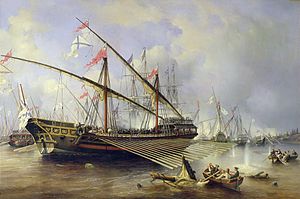Battle of Grengam
| Battle of Grengam | |||||||
|---|---|---|---|---|---|---|---|
| Part of Great Northern War | |||||||
 The Battle of Grengam, 1720 by Ferdinand Victor Perrot. |
|||||||
|
|||||||
| Belligerents | |||||||
|
|
|
||||||
| Commanders and leaders | |||||||
| Vice Admiral Carl Georg Siöblad |
General Mikhail Golitsyn Admiral Matija Zmajević |
||||||
| Strength | |||||||
| 1 Ship of the line 4 frigates 3 galleys 6 smaller craft over 1,000 sailors |
61 galleys 29 boats 11,000 sailors and soldiers |
||||||
| Casualties and losses | |||||||
| 103 killed, 407 taken prisoner, 4 frigates captured |
Russian accounts: 82 killed and 203–236 wounded Swedish accounts: 43 galleys 1,100 to 2,000 killed |
||||||
The Battle of Grengam (Russian: Гренгамское морское сражение, Swedish: Slaget vid Ledsund, or Slaget vid Föglöfjärden. ) of 1720 was the last major naval battle in the Great Northern War that took place in the Åland Islands, in the Ledsund strait between the island communities of Föglö and Lemland. The battle marked the end of Russian and Swedish offensive naval operations in Baltic waters. The Russian fleet conducted one more raid on the Swedish coast in spring 1721, whereupon the Treaty of Nystad was signed, ending the war.
The main shipping route between the ports of in Sweden and Turku in Finland passes through the Åland Islands. It enters the Ledsund strait from south-west with Föglö on the south-east side and Lemland on the north-west. An anchorage (60°0′0″N 20°18′0″E / 60.00000°N 20.30000°ECoordinates: 60°0′0″N 20°18′0″E / 60.00000°N 20.30000°E) of the shore of Flisö in Föglö is protected from the prevailing south-westerly winds by two small islands. This anchorage was previously called Granhamn, Swedish for 'Spruce harbor'. On modern maps it is marked as Rödskärs flädan after the larger of the two protecting islands. The smaller island is now called Granhamns holmen or Granhamn's island. It should not be confused with the island also named Granhamn in the .
...
Wikipedia
